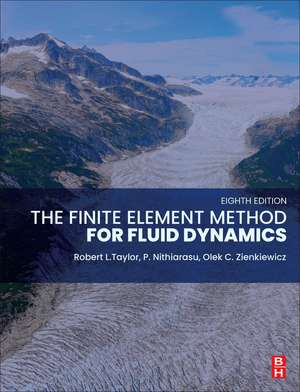The Finite Element Method for Fluid Dynamics
Autor Rl Taylor, P. Nithiarasuen Limba Engleză Hardback – 27 noi 2024
In this expanded eighth edition, the book starts by explaining the character-based split (CBS) scheme, followed by an exploration of various other methods, including SUPG/PSPG, space-time, and VMS methods. Emphasising the fundamental knowledge, mathematical, and analytical tools necessary for successful implementation of computational fluid dynamics (CFD), The Finite Element Method for Fluid Dynamics stands as the authoritative introduction of choice for graduate level students, researchers, and professional engineers.
- A proven keystone reference in the library for engineers seeking to grasp and implement the finite element method in fluid dynamics
- Founded by a prominent pioneer in the field, this eighth edition has been updated by distinguished academics who worked closely with Olgierd C. Zienkiewicz
- Includes new chapters on data-driven computational fluid dynamics and independent adaptive mesh and buoyancy driven flow chapters.
Preț: 703.23 lei
Preț vechi: 914.11 lei
-23% Nou
Puncte Express: 1055
Preț estimativ în valută:
134.58€ • 139.65$ • 112.48£
134.58€ • 139.65$ • 112.48£
Carte tipărită la comandă
Livrare economică 08-22 martie
Preluare comenzi: 021 569.72.76
Specificații
ISBN-13: 9780323958868
ISBN-10: 0323958869
Pagini: 596
Dimensiuni: 191 x 235 mm
Greutate: 1 kg
Ediția:8
Editura: ELSEVIER SCIENCE
ISBN-10: 0323958869
Pagini: 596
Dimensiuni: 191 x 235 mm
Greutate: 1 kg
Ediția:8
Editura: ELSEVIER SCIENCE
Cuprins
1. The equations of fluid dynamics
2. The finite element approximation
3. Convection dominated problems – finite element approximations to the convection–diffusion–reaction equation
4. Fractional step methods: the characteristic-based split (CBS) algorithm for compressible and incompressible flows
5. Incompressible Newtonian laminar flows
6. Incompressible non-Newtonian flows
7. Free surface flows
8. Buoyancy driven flows
9. Compressible high-speed gas flow
10. Adaptive mesh refinement
11. Turbulent flows
12. Flow and heat transport in porous media
13. Shallow-water problems
14. Long and medium waves
15. Short waves
16. Fluid–structure interaction
17. Biofluid dynamics – blood flow
18. Data-driven methods
19. Computer implementation of the CBS algorithm
Appendix A: Self-adjoint differential equations
Appendix B: Non-conservative form of Navier–Stokes equations
Appendix C: Computing drag force and stream function
Appendix D: Convection–diffusion equations: vector-valued variables
Appendix E: Integration formulae
Appendix F: Edge-based finite element formulation
Appendix G: Boundary layer–inviscid flow coupling
Appendix H: Multigrid method
Appendix I: Mass-weighted averaged turbulence transport equations
Appendix J: Introduction to neural networks
2. The finite element approximation
3. Convection dominated problems – finite element approximations to the convection–diffusion–reaction equation
4. Fractional step methods: the characteristic-based split (CBS) algorithm for compressible and incompressible flows
5. Incompressible Newtonian laminar flows
6. Incompressible non-Newtonian flows
7. Free surface flows
8. Buoyancy driven flows
9. Compressible high-speed gas flow
10. Adaptive mesh refinement
11. Turbulent flows
12. Flow and heat transport in porous media
13. Shallow-water problems
14. Long and medium waves
15. Short waves
16. Fluid–structure interaction
17. Biofluid dynamics – blood flow
18. Data-driven methods
19. Computer implementation of the CBS algorithm
Appendix A: Self-adjoint differential equations
Appendix B: Non-conservative form of Navier–Stokes equations
Appendix C: Computing drag force and stream function
Appendix D: Convection–diffusion equations: vector-valued variables
Appendix E: Integration formulae
Appendix F: Edge-based finite element formulation
Appendix G: Boundary layer–inviscid flow coupling
Appendix H: Multigrid method
Appendix I: Mass-weighted averaged turbulence transport equations
Appendix J: Introduction to neural networks
